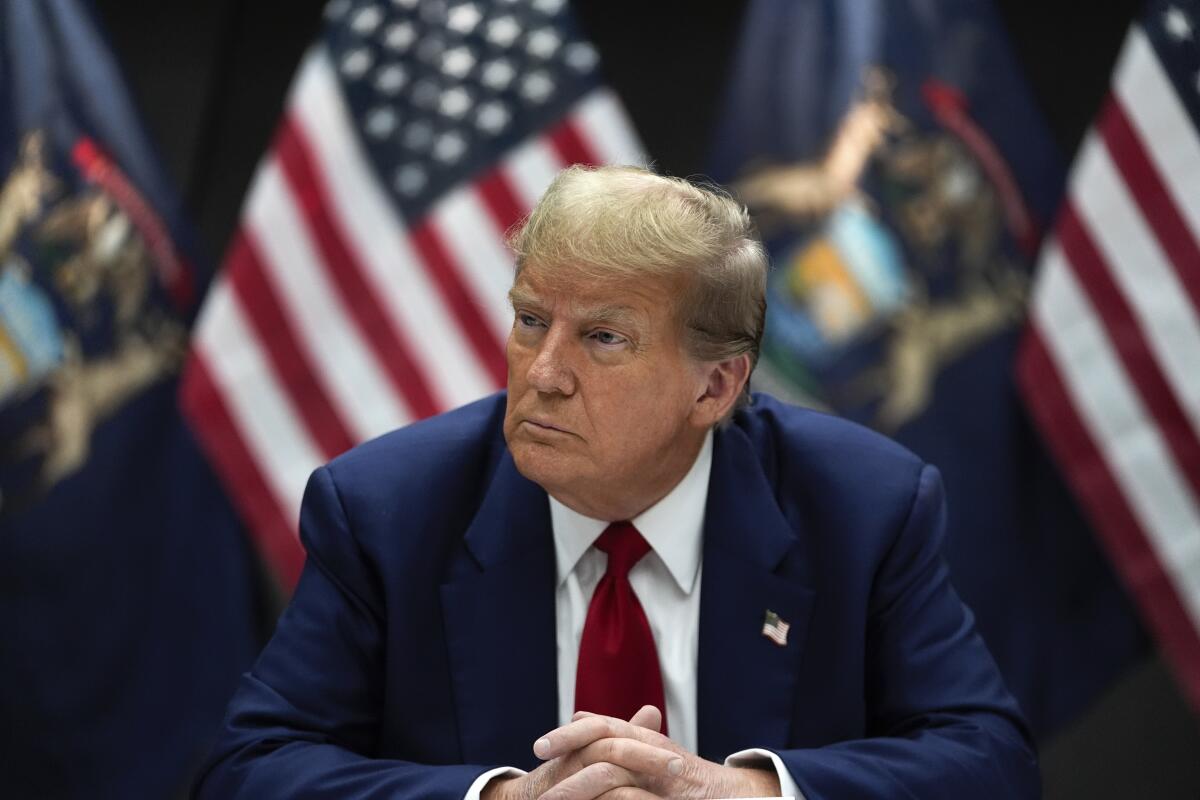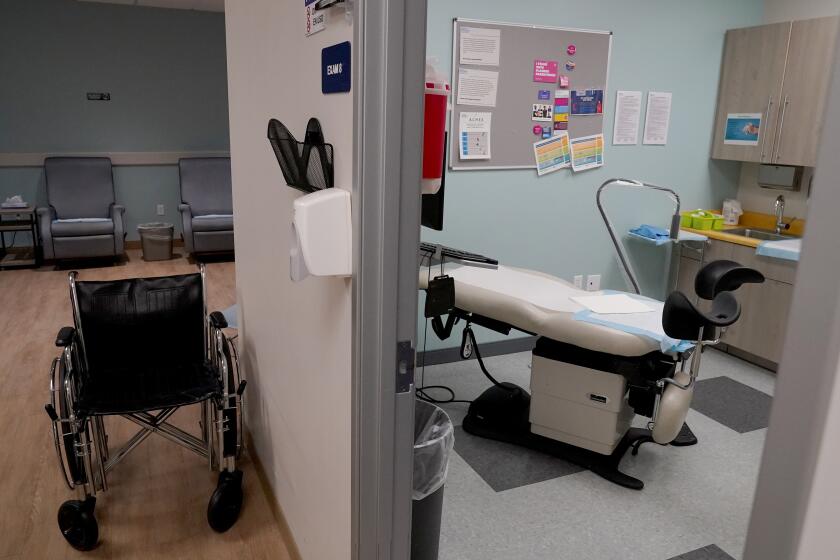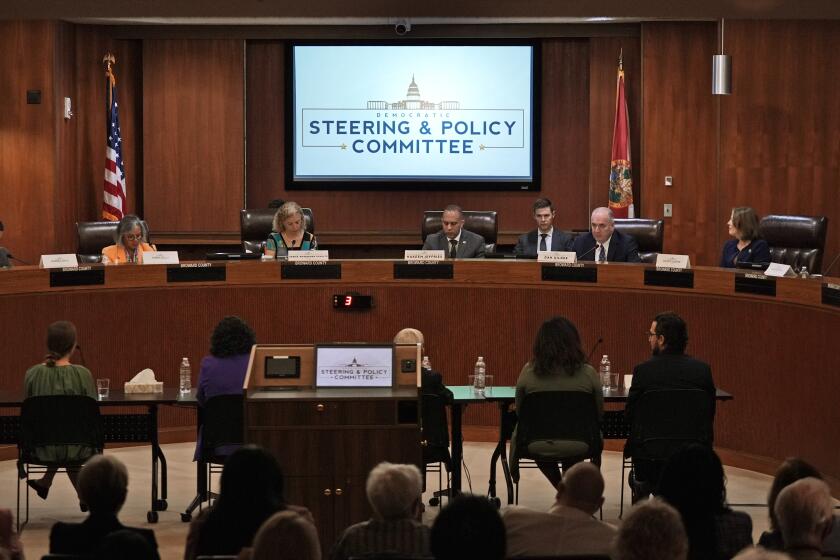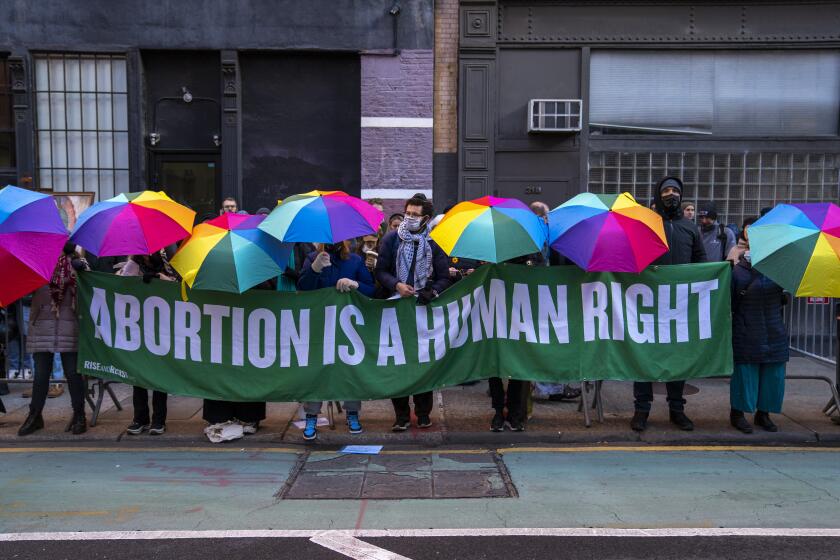Trump says leave abortion to the states. That’s where it gets complicated

- Share via
Former President Trump released his 2024 stance on abortion Monday, saying he supports leaving it up to states to determine abortion access — in essence maintaining the status quo that has existed since the Supreme Court overturned nationwide abortion access in 2022.
“My view is now that we have abortion where everybody wanted it from a legal standpoint, the states will determine by vote or legislation or perhaps both,” Trump said in a video posted to Truth Social, his social media site. “And whatever they decide must be the law of the land — in this case, the law of the state.”
President Biden’s campaign whipped back a response, saying that despite Trump’s claim he would leave it to states to decide, he would support a national ban if in office. The Biden campaign followed up its statement by releasing an ad featuring a Texas woman who was denied an abortion, which would have prevented an infection, after a miscarriage.
“Donald Trump did this,” the ad says.
“Because of Donald Trump, 1 in 3 women in America already live under extreme and dangerous bans that put their lives at risk and threaten doctors with prosecution for doing their jobs,” Biden said in a statement. “And that is only going to get worse.”
But while his long-awaited announcement clarified how his campaign would handle the divisive issue in an election year, Trump’s position is not as simple as it might sound. It reinvigorated the debate over how states have handled abortion access since Roe vs. Wade was overturned two years ago.
The Supreme Court appears unlikely to create further abortion restrictions in its upcoming ruling about the safety of mifepristone. But another threat to abortion access — from a Trump White House — is far more likely to succeed.
‘Leave it to states’ may not be so simple
In the 2022 Dobbs case, the Supreme Court abolished the precedent for nationwide abortion access, returning decision-making power on the divisive issue to states. Since then, states have taken a range of actions to further curtail or protect abortion access — and in many places, the battle is ongoing.
In several states, trigger laws banning abortion went into effect immediately after the Dobbs ruling.
Abortions are largely illegal in Alabama, Arizona, Arkansas, Idaho, Indiana, Kentucky, Louisiana, Mississippi, Missouri, North Dakota, South Dakota, Oklahoma, Tennessee, Texas and West Virginia. Other states — Florida, Georgia, Iowa, Kansas, Nebraska, North Carolina, Ohio, South Carolina, Utah and Wyoming — have sought to curtail abortion access to varying degrees.
In his announcement, Trump acknowledged the mixed status of abortion rights that has resulted from the Supreme Court ruling.
“Many states will be different, many will have a different number of weeks or some will have more conservative than others and that’s what they will be,” he said. “At the end of the day, this is all about the will of the people. You must follow your heart or in many cases, your religion or your faith.”
But having varying state laws affects people everywhere, said Jodi Hicks, president and chief executive of Planned Parenthood of California.
“A healthcare delivery system that sort of bifurcated state by state has an impact on everyone,” Hicks said. “Which is why it’s so important for policymakers to be committed to protecting fundamental rights and reproductive freedom. There is no way to say they’re leaving it to one state or the other because we’re all connected when it comes to healthcare.”
The Arizona Supreme Court says the state can enforce its long-dormant law criminalizing all abortions except when a woman’s life is at stake.
On Tuesday, the Arizona Supreme Court ruled that the state can enforce its 1864 law criminalizing abortions, except when the woman’s life is at risk. But Arizona for Abortion Access, a reproductive rights advocacy group, says it has gathered enough signatures to put the issue on the ballot in November, leaving it up to voters.
California voters responded to the Dobbs ruling by overwhelmingly passing a proposition that codified abortion access in the state Constitution. The proposition received nearly 67% of the vote, establishing Californians’ “fundamental right to choose to have an abortion and their fundamental right to choose or refuse contraceptives.”
In the first election dealing with abortion after Dobbs, Kansas voted to keep constitutional language guaranteeing reproductive rights. But the fight didn’t end there. In the two years since, Republicans in the state Legislature have battled with Democratic Gov. Laura Kelly over how far those protections go.
Republicans in the state House and Senate recently passed a bill that would require healthcare providers to ask patients why they want an abortion, and to record their answers in a state database.
In Maryland, where abortion rights are already protected, state lawmakers put a “reproductive freedom” question on this year’s ballot about whether to add language guaranteeing access to the state Constitution.
In November, Ohio voters overwhelmingly approved a ballot initiative that would create a state constitutional amendment protecting an individual’s right to “contraception; fertility treatment; continuing one’s own pregnancy; miscarriage care; and abortion.”
The amendment allowed that “abortion may be prohibited after fetal viability,” which is decided on a case-by-case basis by the pregnant patient’s physician.
In Florida, where Trump lives, voters will decide whether to enshrine abortion rights in the state’s Constitution in a ballot initiative set for November’s election. The initiative — which barely made it on the ballot after the state Supreme Court eked out a 4-3 decision approving the language last week — requires 60% approval to pass.
Florida’s upcoming law banning abortions earlier in pregnancy is expected to affect providers and people far outside the state.
What it might mean for Republicans
The 2022 midterm — the first election after the Dobbs decision — was widely regarded as a nationwide referendum on abortion access. Polls found that the abortion issue motivated many voters to cast their ballots in the 2022 midterms. And although Republicans took control of the House of Representatives, they did not sweep Congress as they’d hoped.
Many political watchers saw Republicans’ meager showing as proof that Americans want abortion rights reinstated. Since achieving their victory of overturning Roe vs. Wade, GOP politicians have been split on their messaging about what to do next abortion.
“The problem is, you have a pro-life movement that has spent 50 years focused on a unilateral goal,” said Jon Fleischman, a GOP political strategist. “It’s become very clear that what there is not, is a uniformity in the pro-life movement about the next step. And so you’re seeing a broad disagreement about where things should go now.”
In response to Trump’s message Monday, many Republicans jumped into the national conversation to advocate for even stricter measures.
Even in states where abortion access is not under threat, purple districts could turn blue because the right is so out of step with American voters.
Sen. Lindsey Graham (R-S.C.) posted on X that he disagreed with Trump, and called for “a national minimum standard limiting abortion at fifteen weeks because the child is capable of feeling pain, with exceptions for rape, incest and life of the mother.” Trump responded with several posts deriding Graham on Truth Social, saying the senator was harming the Republican Party by harping on the issue.
“Many Good Republicans lost Elections because of this Issue, and people like Lindsey Graham, that are unrelenting, are handing Democrats their dream of the House, Senate, and perhaps even the Presidency,” Trump posted.
“The federal government cannot abandon women and children exploited by abortion. Leaving abortion policy to the states is not sufficient,” said Brian Burch, president of CatholicVote in a statement. “While federal legislation on abortion policy is challenging at present, we are confident that a Trump administration will be staffed with pro-life personnel committed to pro-life policies, including conscience rights, limits on taxpayer funding of abortion, and protections for pro-life states.”
A poll released last week from the Kaiser Family Foundation found that 80% of American adults — including 94% of Democrats, 81% of independents and 70% of Republicans — think women and their doctors, rather than lawmakers, should make decisions about abortions.
More to Read
Get the L.A. Times Politics newsletter
Deeply reported insights into legislation, politics and policy from Sacramento, Washington and beyond. In your inbox three times per week.
You may occasionally receive promotional content from the Los Angeles Times.















